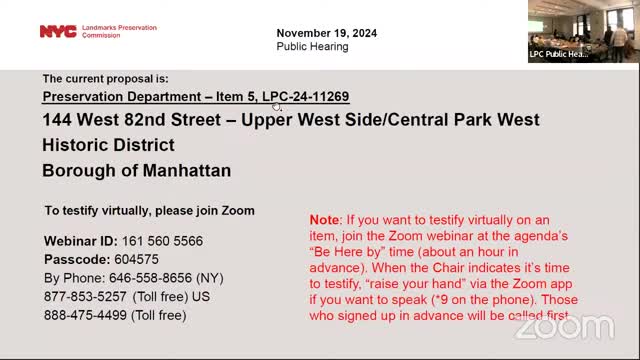Controversial rear addition proposal sparks heated community debate
November 19, 2024 | Land Preservation Commission, New York City Board & Committees, New York City, New York County, New York
This article was created by AI summarizing key points discussed. AI makes mistakes, so for full details and context, please refer to the video of the full meeting. Please report any errors so we can fix them. Report an error »

In a recent meeting of the Landmarks Preservation Commission, architects and community representatives discussed a proposed rear yard addition to a neobrecht-style row house located at 144 West 82nd Street, designed by Ralph S. Townsend and built in 1885. The proposal aims to extend the existing third-floor bedroom over an existing terrace, featuring a glass roof and walls to maintain a minimalist aesthetic in line with the surrounding architecture.
John Gilles, the architect for the project, presented detailed plans and photographs of the site, emphasizing that the addition would not be visible from the street and would harmonize with the existing structures in the area. He noted that the existing addition had already received commission approval, and the current proposal only seeks to add another floor.
However, the proposal faced significant opposition from community representatives. Megan Fitzpatrick from Landmark West argued that the addition would be inappropriate, citing a lack of precedent for such greenhouse structures in the Upper West Side Central Park West Historic District. She expressed concerns about the potential impact on neighboring buildings, particularly regarding light and air access.
Christina Conroy from the Victorian Society in New York echoed these sentiments, criticizing the proposed design for its use of anodized aluminum and the removal of historic fabric. She emphasized the need for contextual information in the presentation materials to allow for informed decision-making by the commission.
Michelle Arbelou from the Historic Districts Council also opposed the addition, labeling it as excessive and inappropriate. In contrast, Manhattan Community Board 7 recommended approval of the project, suggesting the use of bird-proof glass.
After hearing the testimonies, the commissioners engaged in a discussion about the proposal's merits. Several commissioners expressed support for the addition, noting its minimal visibility and compatibility with the surrounding buildings. They emphasized the importance of maintaining the original scale and character of the row house while allowing for modern adaptations.
Ultimately, the commission voted to approve the application with modifications, instructing the applicant to collaborate with staff on the finish of the side walls and the positioning of the glass to ensure a cohesive design that respects the historic context of the district. The decision reflects a balance between preserving the architectural integrity of the area and accommodating contemporary needs.
John Gilles, the architect for the project, presented detailed plans and photographs of the site, emphasizing that the addition would not be visible from the street and would harmonize with the existing structures in the area. He noted that the existing addition had already received commission approval, and the current proposal only seeks to add another floor.
However, the proposal faced significant opposition from community representatives. Megan Fitzpatrick from Landmark West argued that the addition would be inappropriate, citing a lack of precedent for such greenhouse structures in the Upper West Side Central Park West Historic District. She expressed concerns about the potential impact on neighboring buildings, particularly regarding light and air access.
Christina Conroy from the Victorian Society in New York echoed these sentiments, criticizing the proposed design for its use of anodized aluminum and the removal of historic fabric. She emphasized the need for contextual information in the presentation materials to allow for informed decision-making by the commission.
Michelle Arbelou from the Historic Districts Council also opposed the addition, labeling it as excessive and inappropriate. In contrast, Manhattan Community Board 7 recommended approval of the project, suggesting the use of bird-proof glass.
After hearing the testimonies, the commissioners engaged in a discussion about the proposal's merits. Several commissioners expressed support for the addition, noting its minimal visibility and compatibility with the surrounding buildings. They emphasized the importance of maintaining the original scale and character of the row house while allowing for modern adaptations.
Ultimately, the commission voted to approve the application with modifications, instructing the applicant to collaborate with staff on the finish of the side walls and the positioning of the glass to ensure a cohesive design that respects the historic context of the district. The decision reflects a balance between preserving the architectural integrity of the area and accommodating contemporary needs.
View full meeting
This article is based on a recent meeting—watch the full video and explore the complete transcript for deeper insights into the discussion.
View full meeting
